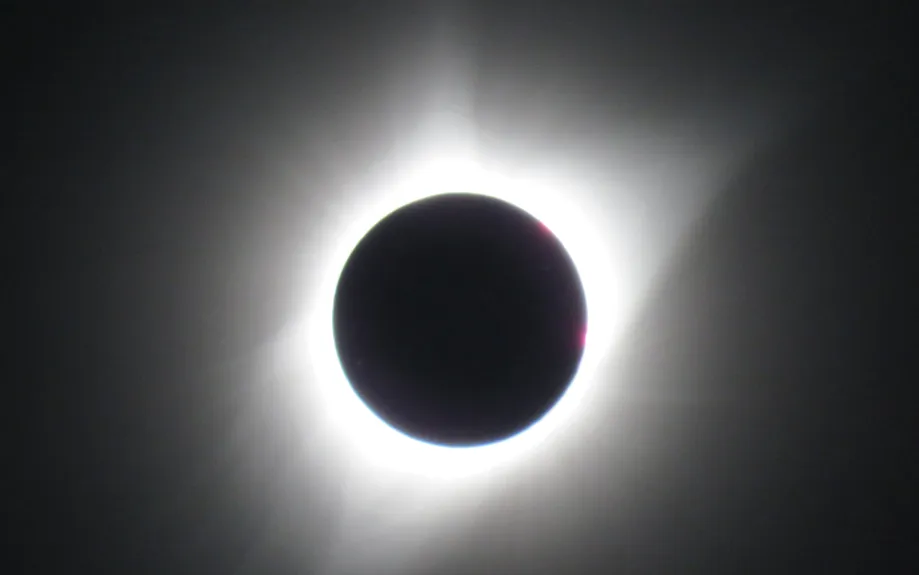It’s all over the news: we will have an eclipse of the sun on Monday, April 8, mid-afternoon, visible all over New England as well as a wide swath across the country.
And, at the time of this writing, it looks like New England just might have a clear view of it. (Fingers crossed! A clear sky in April here is not a given.) And wow oh wow am I getting excited. Like many people, I’m planning to drive north to see the eclipse in totality. There is really nothing like being in the path of totality. That is where you can see the moon fully block the sun, throwing a dark shadow known as the umbra, on a very narrow path along the Earth as the moon moves around us. In totality, which this time will last more than 4 minutes, you can see the sun’s corona, the light effect of Bailey’s beads when the mountains on the moon interfere with our sight of the corona, and feel the difference of having and then not having the heat from our star. Being in the Path of Totality is rare – most people never experience it in their lifetime – and is very different from seeing a partial eclipse.
Now, if you’re not in the path of totality but are somewhere nearby, say, in Connecticut, you’ll still see a pretty dramatic partial eclipse. Outside the path of totality you will be in the penumbra, which is the lighter shadow thrown by the moon. The Latin prefix “pen” means almost, and in this case it refers to the light sneaking around the sides of the moon due to the size of the sun, almost throwing a shadow as dark as the Umbra. You can see this in your own shadow on a sunny day – look at your shadow and you’ll see your darker, smaller shadow surrounded on both sides by your own penumbra.
What we will see in Connecticut is the sun being partially covered by the moon.The farther you are from the path of totality, the less of the Sun will be covered by the Moon. Since Hartford is close to the path of totality, we expect our partial eclipse to be about a 93% coverage of the Sun. That should be impressive. It’ll get pretty dark, the temperature is likely to drop, and the event will be memorable. I vividly remember seeing one as a child at school, watching a reflection of the eclipse on a sheet of paper while my back was turned to the eclipse.
So, what about safety? Everyone is talking about the need to wear eclipse glasses – is it really necessary? The absolute, un-debatable answer is yes. As the moon moves between us and the sun, it gets darker and our eyes dilate to bring more light to the retina in the back of our eyes. But the very strong remaining light from the sun – including its ultraviolet light that we cannot see – enters our wide-open irises and strikes the back of our eye where it does permanent damage to our eyes. That is permanent damage, which can occur in as little as a few seconds. The result is retinal burns (solar retinopathy) that can cause vision loss, distortion, or even blindness – and there is no treatment or cure. Do not look at the eclipse without eclipse glasses. Do not rely on dark sunglasses, and don’t look at the eclipse through a camera lens or other devices – they will not protect you.
There are only two ways to look at an eclipse: wearing eclipse-designed eyewear (eclipse glasses, eclipse lens covers for binoculars, telescopes, and cameras), or indirectly viewing the eclipse by letting the light fall onto something else and looking at that. That is how a “pin-hole camera” works and how I saw the eclipse on a piece of paper as a child. And remember to keep your pets from looking at the eclipse, too. Leave the dogs inside or under shade.

2017 Solar Eclipse Composite. By Chris Fisher.
Whether you will see the total eclipse or a partial, this is big deal. Eclipses of the sun are rare – the next one in the lower 48 will be in 2044 – and they leave lifetime memories. The one on Monday has the potential to be seen over much of the country and is already sparking celebrations. I encourage everyone to rejoice in this phenomenon and watch it safely.
As for me, I am keeping my fingers crossed for clear skies on Monday, already have a nerdy T-shirt to wear to school on Friday, and am driving north for Monday. I’m not an eclipse-chaser (some people are) but I did drive to Wyoming in 2017 to see my first totality. Words really can’t express the awe, beauty, and inspiration that comes from a total solar eclipse. I can’t wait for this one.
Sarah Faulkner of Collinsville teaches eighth grade science in East Granby. Now in her 25th year of teaching, she holds a bachelor’s degree and master’s degree in biology, an Ed.D. in educational leadership, and is an undeniably enthusiastic advocate for all things sciencey.


